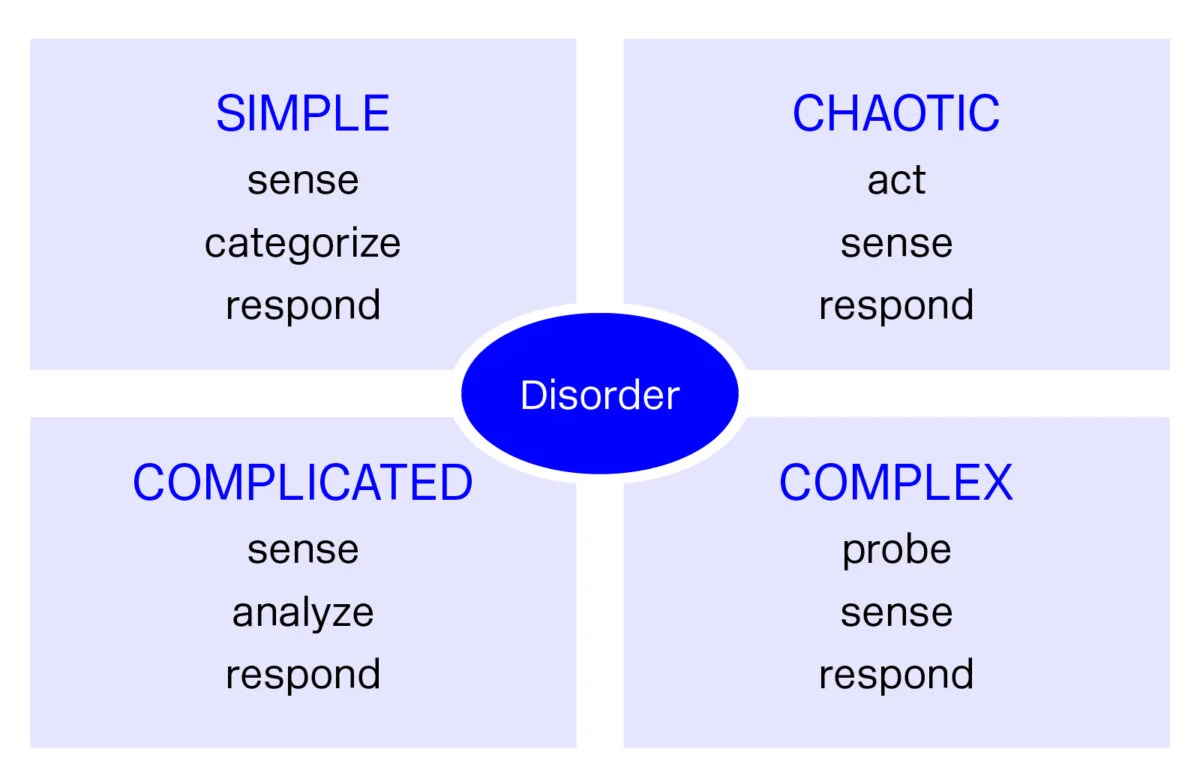Using the Cynefin framework to develop problem-solving approaches appropriate to the situation
Growing complexity, best described by the term “VUCA”, is one of the biggest challenges for managers. One approach to tackling this complexity is the Cynefin framework. We explain how the model works.

Using the Cynefin framework to develop problem-solving approaches appropriate to the situation
Many problem-solving strategies reach their limits when it comes to the complex decisions you have to make as a manager. Especially in the “VUCA world” – VUCA is an acronym that stands for Volatility, Uncertainty, Complexity, and Ambiguity – you cannot always rely on tried-and-tested methods or best practices. The Cynefin framework can provide the answer here. Developed by research scientist Dave Snowden, the knowledge management system helps managers categorize management situations correctly and identify the right approach based on this. After all, deciding whether a traditional management style or a more agile course of action is needed depends greatly on the complexity of the pending task or challenge.
The five domains of the Cynefin framework
The Cynefin model (Cynefin is the Welsh word for origin or habitat) comprises five domains, which primarily differ in terms of their cause-and-effect relationship:
- Simple: In simple situations, the cause-and-effect relationships are clear, and the problem-solving approach is easy to identify and pursue. Accordingly, the recommended course of action is: sense – categorize – respond. Best practices from similar situations can be drawn on here.
- Complicated: Complicated situations also have a clear cause-and-effect relationship. However, expert knowledge is required to make decisions because non-linear processes and several variables form the starting point here. The more complicated the system is, the more important it is for project participants to communicate with each other and to conduct a thorough analysis of the situation. The course of action should follow this pattern: sense – analyze – respond.
- Complex: A situation is complex when there are too many variables to identify the cause-and-effect relationship in advance and come up with a reliable solution. Complex situations are usually agile, and their individual factors change – agile management methods should therefore be used here. A complex situation can be tackled through trial and error, creativity, diversity, and constant communication (probe – sense – respond).
- Chaotic: In chaotic systems, there is no apparent causal chain whatsoever. Old structures and processes do not work, and new ones have not been established yet. Swift action and a strong leader are needed to move the chaotic situation into a different domain. The emerging simple, complicated, or complex situation can then be reacted to appropriately (act – sense – respond). Chaotic situations can be compared to a stock market crash – an unclear situation that seems impossible to bring order to.
- Disorder: What exactly is the current situation? If you are not certain what kind of cause-and-effect relationship you are dealing with, it’s important to make sure that you don’t fall back into your comfort zone and choose convenient solutions simply because you are familiar with them. Embracing the confusion and actively observing patterns of actions and behavior can help you pursue new paths and take away lessons for future unclear situations.

Important note: The boundaries between the individual domains of the Cynefin matrix can be fluid. This means: Situations that may have been complex at the beginning can become complicated or even simple through analysis or processes – project management must be adapted accordingly. If a simple situation becomes chaotic, the only way to make it simple again is to work through the complex scenario and the ensuing complicated scenario.
Typical mistakes when applying the Cynefin framework
The Cynefin framework is a pragmatic decision-making model, which focuses on solving the situation currently at hand and not on the future success of a project. If you do not keep this in mind, problems may arise with regard to the project management or the project could fail entirely.
Applying the simple strategy for a complex or complicated situation: Simple situations are easier to deal with. A lot of managers therefore tend to distort and simplify the situation at play. This can result in fatal decisions being made, thereby jeopardizing the success of the project.
Tackling a complex situation using the strategies for a complicated situation: A complicated system is managed with expert knowledge and thorough analyses. However, if you use this approach in a complex system, there is a great risk of getting caught up in analysis loops and ineffective processes.
Failing to recognize a chaotic situation: If the system becomes chaotic, a quick response and the right management technique are vital to get on top of the chaotic situation as quickly as possible. If, as a manager, you act too hesitantly or enact rules that are less than ideal for the company, it can lead to long-term damage.
Conclusion: Every problem requires its own solution strategy
With the Cynefin framework, Snowden has created a decision-making model that helps managers identify current situations correctly and align their actions accordingly. Anyone who always addresses a problem using the same strategy will inevitably fail.





